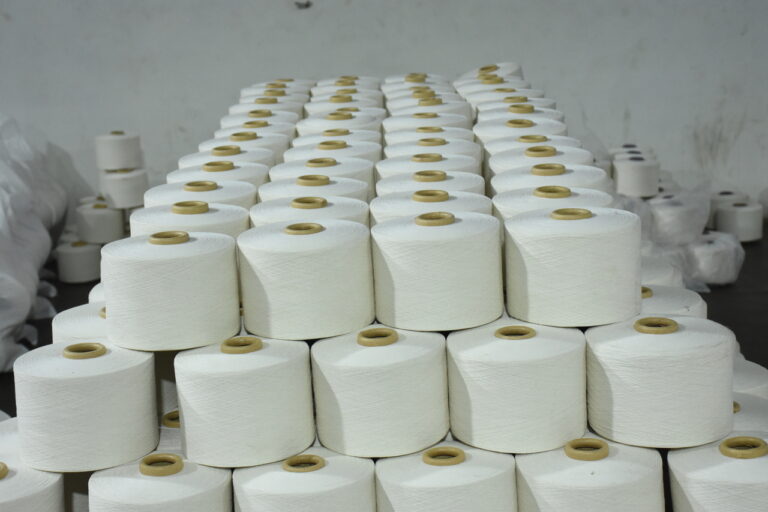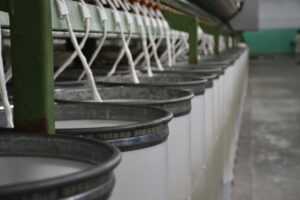
We produce yarn according to our customer’s requirements.

The basic requirements and functions of a ring-spinning frame are:
a) fiber supply,
b) drafting,
c) twisting, and
d) package winding.
The fiber supply, usually in the form of roving and having a hank* range from approximately 0.40 to 5.0, is drawn into the drafting system by the rotation of the back rolls. In the drafting zone, the weight per unit length of the input roving is reduced because the surface speed of the front drafting rolls is greater than that of the back rolls. Normal ring frame drafts range up to about 30.
The front rolls deliver a continuous cohesive stream of fibers, which must be twisted immediately into yarn. This transformation is accomplished by the interactions of the spindle, ring, and traveler. The rotation of the spindle causes a twist to be inserted into the stream of fibers delivered by the front rolls. Bypassing the yarn under the traveler, the winding is accomplished.
The spindle serves three functions: first, it provides a location to wind a package; secondly, by rotating the yarn package, the spindle causes a twist to be inserted into the strand of yarn being formed at the nip of the front rolls; thirdly, the rotation of the package causes the yarn to pull the traveler around the ring, providing a method of not only transmitting twist derived from the spindle, but also a guide to change the direction of yarn travel so that it approaches the yarn package tangentially, and thus can be wound onto the package.
The heart of the open-end process is a rotor, wherein fibers can be collected and then drawn off as a yarn. For short staple spinning, most rotors are 31 to 56 millimeters in diameter and may contain a shallow “U” or “V” shaped fiber alignment groove around their periphery. In open-end spinning, the rotor rotation provides the twisting force.
Twist has traditionally been inserted into yarn by rotating the package upon which the yarn is being wound. In the case of open-end spinning, the twisting force is generated by the rotation of a rotor and is transmitted by friction to the fibers that make up the tail of the newly-formed yarn. As this twisting tail comes into contact with other fibers, it collects them. Once this process is started, it is self-sustaining, and yarn can then be drawn out of the rotor continuously. In order to prevent twists from being transmitted throughout the length of the fibers that are available for collection into yarn, it is necessary that these fibers not be in any significant frictional contact with one another. It is from this requirement, that the supply fibers not be in intimate frictional contact, that open-end spinning derives its descriptive name. This lack of contact allows true twists to be inserted into the yarn, and at the same time, prevents twists from being transmitted throughout the fiber supply, which would result in instant stripping of the rotor.
Differences: The basic difference between ring-spun yarns and open-end spun yarns is in the way they are formed. The former produces yarn by inserting twist into a continuous ribbon-like strand of cohesive fibers delivered by the front rolls, while the latter forms yarn from individual fibers directly by collecting them from the inside surface of a rotor by twist forces. Thus, for comparison, it could be said that a ring yarn is formed from the outside in, while an open-end yarn is formed from the inside out.
The elements basic to the production of open-end yarns are somewhat different from ring spinning. They are:
a) fiber supply,
b) drafting system,
c) fiber collection and alignment,
d) twist insertion — yarn formation and e) package winding.
When this fact is considered, it becomes apparent that the total draft for a given yarn produced on an open-end machine will be greater than that of a ring frame producing the same yarn. For instance, the draft of an open-end frame producing 24/1 from 60-grain sliver would be 172.8, while the draft on a ring frame producing the same 24/1 yarn from 0.80 hanks roving would be 30.
Thus, the overall draft of an open-end frame is likely to be quite high; as a result, open-end equipment manufacturers decided to abandon roller drafting as being too cumbersome to use to develop the high drafts required for rotor spinning.
In place of roller drafting, a simple wire or pin-covered cylinder several inches in diameter and about an inch wide is used. This beater, or combing roll, as it is normally referred to, works just like a card flickering; it is, in fact, covered with metallic card wire, or possibly steel pins.
The rotational speed of a combing roll ranges from about 3,000 to 10,000 rpm with 4,000 to 8,000 being most common.
In actual operation, the supply sliver is presented to the rotating teeth of the combing roll by the action of a feed roll/feed plate mechanism. When the position is started, a brake is released that allows the feed roll to pull a sliver between itself and the feed plate, and thus present a beard of fibers to the combing roll.
There is a very high draft between the feed roll/feed plate and the rotor. This draft normally will vary in a range from 1,000 to 40,000 or higher, depending on the count produced, draft, and required twist. This high draft delivers individual fibers and/or small individual fiber groups to the rotor where they are deposited randomly around the inside of the rotor over a period of many revolutions.
This deposited fiber mass has very little fiber-to-fiber cohesiveness, and it is this fact that makes open-end spinning possible.
The combing roll combs out fibers and carries them to the fiber transport duct that connects the combing roll chamber to the rotor chamber. A combination of centrifugal force and air suction from the rotor chamber tends to strip the fibers away from the combing roll and send them into the fiber transport duct.
The fiber transport duct is aimed tangentially at the rotor’s fiber alignment groove. This duct exit usually is located very close to the groove to prevent newly-arrived fibers from being collected by the newly-formed yarn before ever reaching the rotor alignment groove. Some manufacturers choose to align the fiber delivery tube so that fibers entering the rotor first contact the rotor wall just above the fiber groove, and then slide down the wall into the groove. These manufacturers believe that better fiber alignment is obtained using this method. Other machinery manufacturers do not use the fiber delivery duct to direct the fibers into the rotor groove, but rather use a separator plate to direct newly-arrived fibers into the fiber alignment groove.

Wecusandae debitis facere quidem animi placeat maxime cuuntur at voluptatiWecusandae debitis facere quidem animi placeat maxime cuuntur at voluptatib uod numuam pariatur libero laborum laudantium non. Vitae optio nisi ut aliquip ex ea commodo ornare aenean euismod.Wecusandae debitis facere quidem animi placeat maxime cuuntur at voluptatiWecusandae debitis facere quidem animi pla
We produce yarn according to our customer’s requirements.
Knitting yarns require small twists and even yarns to ensure thick piles, good elasticity, and strong warmth retention of knitted sweaters. The yarn for weaving is required to be light, the weft yarn is less knotted, and the evenness.
The specification of cotton yarn mainly depends on what the cotton yarn is used for, so what are the common cotton yarns? Let’s take a look at the classification of cotton yarn!
Varius sit amet mattis vulputate enim nulla. Viverra maecenas accumsan lacus vel facilisis. Convallis tellus id interdum velit.